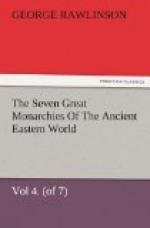Now the evidence which we possess on this point is threefold. It consists of certain notices in the Hebrew Scriptures, contemporary records of first-rate historical value; of an account which strangely mingles truth with fable in one of the books of the Apocrypha; and of a passage of Berosus preserved by Josephus in his work against Apion. The Scriptural notices are contained in Jeremiah, in Daniel, and in the books of Kings and Chronicles. From these sources we learn that the Babylonian Empire of this time embraced on the one hand the important country of Susiana or Elymais (Elam), while on the other it ran up the Euphrates at least as high as Carchemish, from thence extending westward to the Mediterranean, and southward to, or rather perhaps into, Egypt. The Apocryphal book of Judith enlarges these limits in every direction. That the Nabuchodonosor of that work is a reminiscence of the real Nebuchadnezzar there can be no doubt. The territories of that monarch are made to extend eastward, beyond Susiana, into Persia; northward to Nineveh; westward to Cilicia in Asia Minor; and southward to the very borders of Ethiopia. Among the countries under his sway are enumerated Elam, Persia, Assyria, Cilicia, Coele-Syria, Syria of Damascus, Phoenicia, Galilee, Gilead, Bashan, Judsea, Philistia, Goshen, and Egypt generally. The passage of Berosus is of a more partial character. It has no bearing on the general question of the extent of the Babylonian Empire, but, incidentally, it confirms the statements of our other authorities as to the influence of Babylon in the West. It tells us that Coele-Syria, Phoenicia, and Egypt, were subject to Nabopolassar, and that Nebuchadnezzar ruled, not only over these countries, but also over some portion of Arabia.
From these statements, which, on the whole, are tolerably accordant, we may gather that the great Babylonian Empire of the seventh century B.C. inherited from Assyria all the southern and western portion of her territory, while the more northern and eastern provinces fell to the share of Media. Setting aside the statement of the book of Judith (wholly unconfirmed as it is by any other authority), that Persia was at this time subject to Babylon, we may regard as the most eastern portion of the Empire the district of Susiana, which corresponded nearly with the modern Khuzistan and Luristan. This acquisition advanced the eastern frontier of the Empire from the Tigris to the Bakhtiyari Mountains, a distance of 100 or 120 miles. It gave to Babylon an extensive tract of very productive territory, and an excellent strategic boundary. Khuzistan is one of the most valuable provinces of modern Persia. It consists of a broad tract of fertile alluvium, intervening between the Tigris and the mountains, well watered by numerous large streams, which are capable of giving an abundant irrigation to the whole of the low region. Above this is Luristan, a still more pleasant district, composed of alternate mountain, valley, and upland plain, abounding




